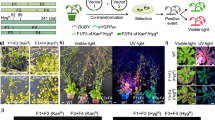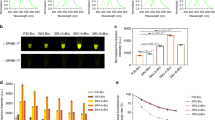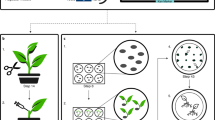Abstract
A wound-induced promoter (AoPRl) isolated from Asparagus officinalis was shown by GUS reporter gene analysis to be active during callus formation in tissue cultured leaves from transgenic tobacco plants. Unlike other promoters commonly used to drive expression of marker genes during transformation (e.g. Nos, MAS-35S and CaMV35S), the AoPR1 promoter showed strong expression at wound sites during tobacco leaf disk transformation but was expressed at extremely low levels in the leaves, roots and seeds of the mature plant. A plant transformation vector was constructed in which nptII expression was placed under the control of the AoPR1 promoter. This construct was then used in transformation experiments which resulted in the production of a large number of transgenic tobacco and potato plants. In leaves, roots and tubers (in the case of potato) of these plants, the marker gene protein product (NPTII) was present in low amounts compared to the levels found in control transgenic plants produced using a CaMV35S-nptII gene as a selectable marker.
This is a preview of subscription content, access via your institution
Access options
Subscribe to this journal
Receive 12 print issues and online access
$209.00 per year
only $17.42 per issue
Buy this article
- Purchase on Springer Link
- Instant access to full article PDF
Prices may be subject to local taxes which are calculated during checkout
Similar content being viewed by others
References
Vancanneyt, G., Schnlidt, R., O'Connor-Sanchez, A., Willmitzer, L. and Rocha-Sosa, M. 1990. Construction of an intron-containing marker gene: Splicing of the intron in transgenic plants and its use in monitoring early events in Agrobacterium-mediated plant transformation. Mol. Gen. Genet. 220: 245–250.
Janssen, B.-J. and Gardner, R.C. 1989. Localized transient expression of GUS in leaf discs following cocultivation with Agrobacterium. Plant Mol. Biol. 14: 61–72.
Higgins, E.S., Hulme, S. and Shields, R. 1992. Early events in transformation of potato by Agrobacterium tumefaciens. Plant Sci. 82: 109–118.
Potrykus, I. 1990. Gene transfer to cereals: an assessment. Bio/Technology 8: 535–542.
Flavell, R.B., Dart, E., Funchs, R.L. and Fraley, R.T. 1992. Selectable marker genes: safe for plants? Bio/Technology 10: 141–142.
Bevan, M. 1984. Binary Agrobacterium vectors for plant transformation. Nucl. Acids Res. 12: 8711–8721.
Bowles, D.J. 1990. Defence-related proteins in higher plants. Annu. Rev. Biochem. 59: 873–907.
Dixon, R.A. and Harrison, M.J. 1990. Activation and organisation of genes involved in microbial defense in plants. Adv. Genet. 28: 165–234.
Warner, S.A.J., Scott, R. and Draper, J. 1992. Characterisation of a wound-induced transcript from the monocotyledon asparagus that shares homology with a new class of pathogenesis-related (PR) proteins. Plant Mol. Biol. 19: 555–561.
Warner, S.A.J., Scott, R. and Draper, J. 1992. Isolation of asparagus AoPRl wound-responsive promoter by the inverse polymerase chain reaction and its characterisation in transgenic tobacco. Plant Journal, In press.
Walter, M.H., Jian-Wei, L., Grand, C., Lamb, C.J. and Hess, D. 1990. Bean pathogenesis-related (PR) proteins deduced from elicitor-induced transcripts are members of a ubiquitous new class of conserved PR proteins including pollen allergens. Mol. Gen. Genet. 222: 353–360.
Stermer, B.A., Schmid, J., Lamb, C.J. and Dixon, R.A. 1990. Infection and stress activation of bean chalcone synthasc promoters in transgenic tobacco. Mol. Plant Microh. Interact. 3: 381–388.
Dixon, R.A. and Lamb, C.J. 1990. Molecular communication in interactions between plants and microbial pathogens. Ann. Rev. Plant Phys. and Plant Mol. Biol. 41: 339–367.
An, G., Costa, M.A. and Ha, S.H. 1990. Nopaline synthase promoter is wound inducible and auxin inducible. The Plant Cell 2: 225–233.
Langridge, W.H.R., Fitzgerald, K.J., Koncz, C., Schell, J. and Szalay, A.A. 1989. Dual promoter of Agrobacterium tumejaciens mannopine synthase genes is regulated by plant growth hormones. Proc. Natl. Acad. Sci. USA 86: 3219–3223.
Draper, J., Scott, R., Armitage, P. and Walden, R. 1988. Plant Genetic Transformation and Gene Expression. A Laboratory Manual. Blackwell Scientific Publications, Oxford, UK.
Lipetz, J. 1966. Crown gall tumorigenesis II. Relations between wound healing and tumorigenic response. Cancer Research 26: 1597–1605.
Paul, E., Harikrishna, K., Fioroni, O. and Draper, J. 1989. Dedifferentiation of Asparagus officinalis L. mesophyll cells during initiation of cell cultures. Plant Sci. 65: 111–117.
Harikrishna, K., Paul, E., Darby, R. and Draper, J. 1991. Wound response in mechanically isolated asparagus mesophyll cells: A model monocotyledon system. J. Exp. Bot. 42: 791–799.
Harpster, M.H., Townsend, J.A., Jones, J.D.G., Bedbrook, J. and Dunsmuir, P. 1988. Relative strengths of the 35S cauliflower mosaic virus. 1′, 2′ and nopaline synthase promoters in transformed tobacco, sugarbeet and oil seed rape callus tissue. Mol. Gen. Genet. 212: 182–190.
Comai, L., Moran, P. and Maslyar, D. 1990. Novel and useful properties of a chimeric plant promoter combining CaMV 35S and MAS elements. PI. Mol. Biol. 15: 373–381.
Fromm, M., Taylor, L.P. and Walbot, V. 1985. Expression of genes transferred into monocot and dicot plant cells by electroporation. Proc. Natl. Acad. Sci. USA 82: 5824–5828.
Deblaere, R., Bytebier, B., De Greve, H., Deboeck, K., Schell, J., Van Montagu, M. and Leemans, J. 1985. Efficient octopine Ti plasmid derived vectors for Agrobacterium-mediated gene transfer. Nucl. Acids Res. 13: 4777–4788.
Wen-jun, S. and Forde, B.G. 1989. Efficient transformation of Agrobacterium spp. by high voltage electroporation. Nucl. Acids Res. 17: 83–85.
Jefferson, R.A. 1987. Assaying chimeric genes in plants: the GUS gene fusion system. Plant Mol. Biol. Rep. 5: 387–405.
Bradford, M.M. 1976. A rapid and sensitive method for the quantitation of microgram quantities of protein utilizing the principle of protein dye binding. Anal. Biochem. 72: 248–254.
McDonnell, R.E., Clark, R.D., Smith, W.A. and Hinchee, M.A. 1987. A simplified method for the detection of neomycin phosphotransferasc II activity in transformed plant tissues. Plant Mol. Biol. Rept. 5: 380–386.
Author information
Authors and Affiliations
Rights and permissions
About this article
Cite this article
Özcan, S., Firek, S. & Draper, J. Selectable Marker Genes Engineered for Specific Expression in Target Cells for Plant Transformation. Nat Biotechnol 11, 218–221 (1993). https://doi.org/10.1038/nbt0293-218
Received:
Accepted:
Issue Date:
DOI: https://doi.org/10.1038/nbt0293-218
This article is cited by
-
Tissue-specific and stress-inducible promoters establish their suitability for containment of foreign gene(s) expression in transgenic potatoes
3 Biotech (2020)
-
Expression of GNA and biting site-restricted cry1Ac in cotton; an efficient attribution to insect pest management strategies
Plant Biotechnology Reports (2018)
-
Targeted expression of insecticidal hybrid SN19 gene in potato leads to enhanced resistance against Colorado potato beetle (Leptinotarsa decemlineata Say) and tomato leafminer (Tuta absoluta Meyrick)
Plant Biotechnology Reports (2017)
-
Towards better insect management strategy: restriction of insecticidal gene expression to biting sites in transgenic cotton
Plant Biotechnology Reports (2016)
-
Agrobacterium-Mediated Genetic Transformation of Pogostemon cablin (Blanco) Benth. Using Leaf Explants: Bactericidal Effect of Leaf Extracts and Counteracting Strategies
Applied Biochemistry and Biotechnology (2012)



